Stories
The Denim Decade
1980s
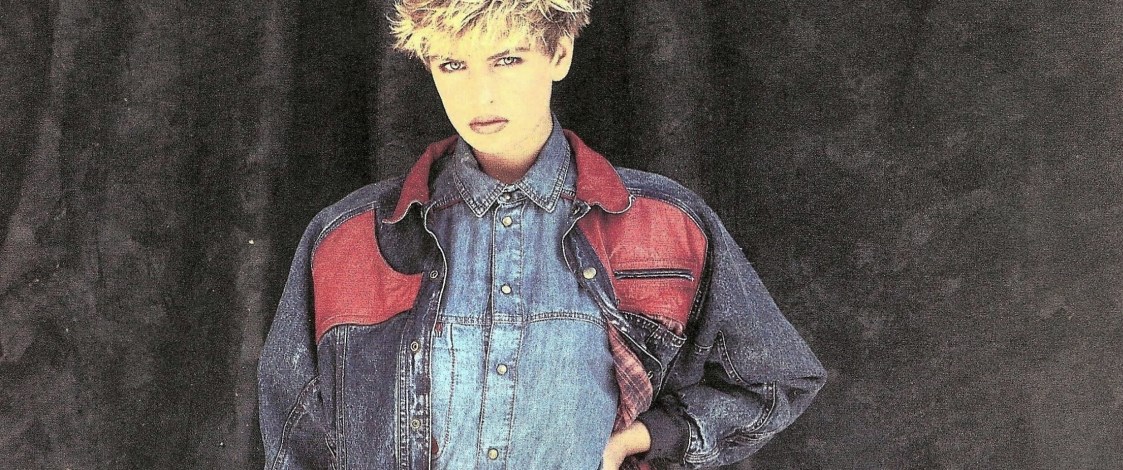
Denim in itself wasn’t new in the 1980s but its prevalence, variety of design and versatility became something of a female fashion phenomenon in New Zealand. The new affinity for denim encompassed shirts, skirts, shorts, dresses, bustiers and jackets as well as jeans. Wearing more than one denim piece at a time - a jacket with jeans for example - was referred to as 'double denim'.
Although Levi Strauss introduced a line of blue denim jeans for women (Lady Levis) as early as 1934, jeans remained almost exclusively in the male domain, worn primarily as tough work trousers by the likes of farmers, labourers, factory workers, miners and cowboys.
The transition from workwear to leisurewear, and the acceptance of jeans for both sexes, began in the 1950s. With the birth of teen culture, denim jeans took on a new meaning as the insignia of the young. Romanticised by images of Marlon Brando (The Wild One), James Dean (Rebel Without a Cause) and movie stars Marilyn Monroe and Doris Day who wore them on and off screen, blue jeans signalled a youthful energy and hunger for change. Pedal-pushers, women’s mid-calf length jeans with a turned-up cuff, were a big hit with young New Zealanders.

Marilyn Monroe wearing denim pedal-pushers, 1950s.
In the 1970s, hippies put their mark, quite literally, on blue denim, personalising flares, cut-offs, mini-skirts and shorts with embroidery, applique and painted motifs. Rips, tears and frayed hems were other forms of customisation.
In the same decade, Aucklanders MaryJane and Phil O’Reilly launched Black Sheep, a range of heavyweight 14oz denim jeans, overalls, waistcoats, jackets, skirts and bags that they cut and sewed at home and sold at the Cook Street Market.
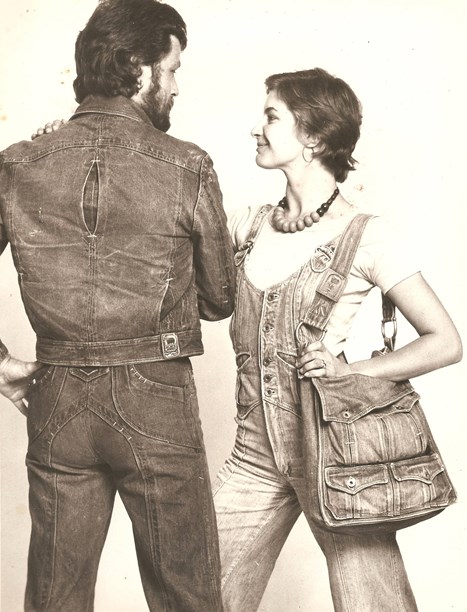
Mary Jane and Phil O’Reilly wear Black Sheep denims, 1970s.
While Black Sheep’s designs referenced denim’s workwear origins, denim pieces accessorised with ankle socks, platforms and denim-appropriate hats, shown by Thornton Hall in a 1970s’ Hullabaloo fashion parade, asserted their street credibility.
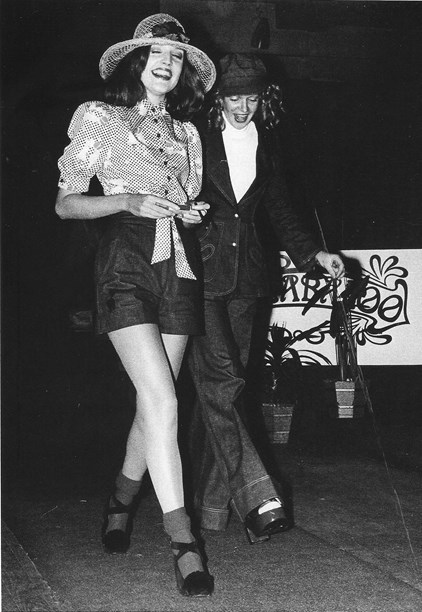
Hullabaloo fashion parade, 1970s. Model on left: Judith Baragwanath.
Overseas, Calvin Klein, Ralph Lauren, Gloria Vanderbilt and other fashion notables started putting their names on jeans pockets, giving rise to a new term – designer denim. By the 1980s, the New Zealand jean scene had expanded to include big name international denim brands, made here under license, and home-grown labels that either specialised in denim fashion or incorporated it in their seasonal ranges. Some companies, such as Christchurch-based Peter Dynes Denims, makers of Cody, Asphalt and Skin Jeans, had more than one label.

Skin Jeans advertisement, 1988. Model: Kirsteen Price. Photo by Euan Sarginson.
Denim came in different weights, 7oz being the lightest, 14oz the heaviest. Down Under Denim, the Australian mill from which a number of New Zealand jean-makers sourced their denim, offered six weights and the option of stretch. Stretch denim jeans provided a better fit and, because of their flexibility, were more comfortable to wear.
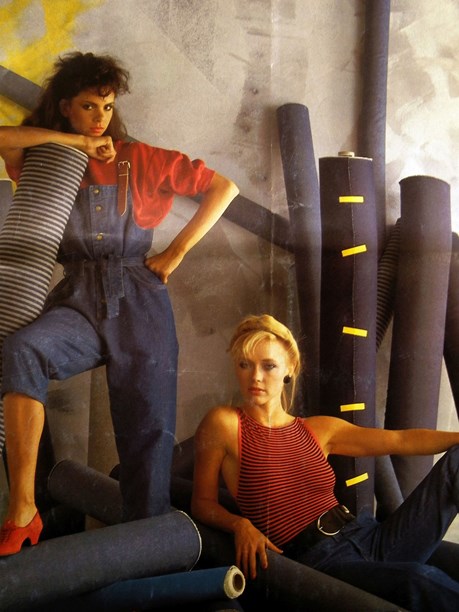
Denim promotion, Apparel magazine, 1984.
Washed-out effects challenged unrelieved blue. Various techniques were used to achieve the faded look but stone-washing was one of the most common. In an article in Apparel magazine, Bob Robertson, the director of Robertsons Ltd, manufacturers of the Amco, Matches and Spaghetti labels for men, women and children, lauded the stone-washing process - which involved pounding the cloth with stones in an industrial washing machine - for its ability to make denim look worn in without being worn out. Although indigo and other shades of blue remained popular, denim was also available in other colours, most notably black, sometimes washed to dark grey.

Spaghetti washed denim bustier and double waistband jeans, 1988.
For the most part, there is only so much that can be achieved with one particular fabric but in the case of denim, which also had a fairly restrictive colour palette, there were few limitations. The inventiveness of the denim designers knew no bounds. In 1986, informed by the current trend for tapestry bags and shoes, Sasson embellished a washed blue denim jacket and jodhpur jeans with tapestry touches, lending a dandified air to an otherwise casual outfit. Dollying up a spare denim dress with a triple-ruffled skirt, as Society Fashions did in 1987, was another example of thinking outside the square.
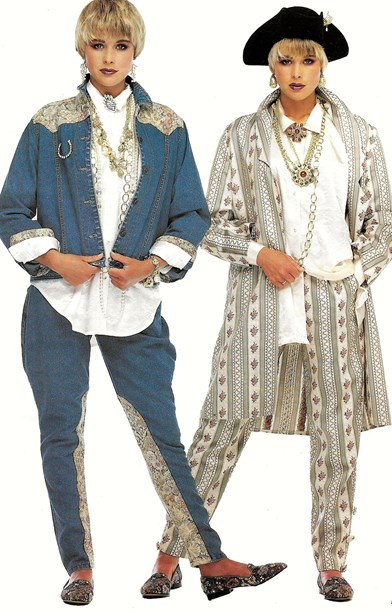
Sasson tapestry-trimmed denim jacket and jodhpur jeans (left), Suzanne Gregory tapestry coat and pants (right). Tapestry shoes by Marler. Fashion Quarterly, Winter 1986.
Vamp, established by Walter Hart in 1973, used patchworks of contrasting colour in its denim designs, giving them a special freshness and exuberance. Red, green and yellow appliques on a blue cropped jacket would be picked up in the exposed pocket openings of matching jeans. Flashes of red on a jacket might reappear on the basque of a skirt or in the jacket’s lining, making it possible to co-ordinate a total look.
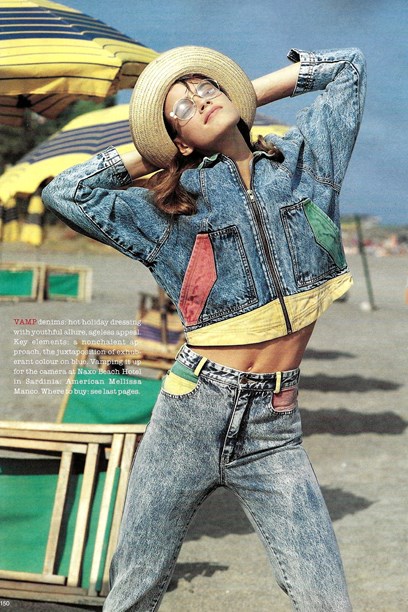
Vamp distressed denim cropped jacket and jeans. Fashion Quarterly, Summer 1987.
Taking advantage of the lighter-weight denims, Thornton Hall created ankle-grazing shirtwaist dresses with full skirts and button-through playsuits. The lightness of the fabric gave it drape, resulting in a softer, more feminine look.
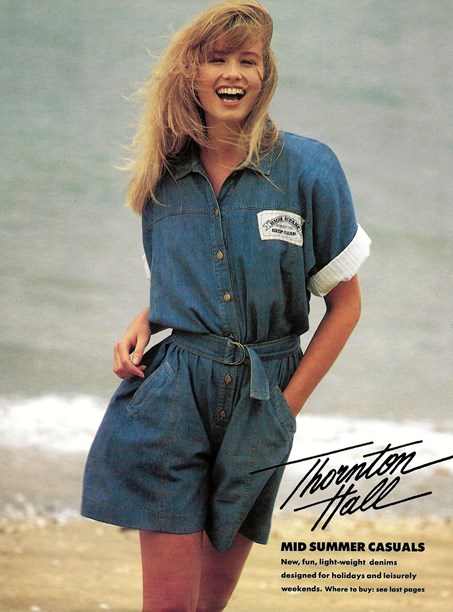
Thornton Hall lightweight denim playsuit, 1988.
Designer Ches Pritchard, who worked on Thornton Hall’s Puritan label, recalls making denim jackets, tailored jeans, pantsuits, culottes and bib-front pinafores in Hush Bunny, an American stretch denim with a brushed surface. "The ranges, which were designed for stylish older women with more conservative tastes, were immensely popular, particularly for golf and other outdoor pursuits."
For Jag, the denim difference was in the details – Western style fringing, a jewelled pocket or a fluted double peplum on a jacket, leopard trim on a cuff. Shirts were made more modish with the addition of nautical emblems or embroidered writing. The Hall Corporation, whose headquarters were in Pakuranga, Auckland, was the New Zealand franchisee for Jag and its sister label Adele Palmer. While acknowledging that Jag denims had a definite high fashion component, Wendy Hall told Fashion Quarterly that although the label touched on current faddisms it was never dominated by them.
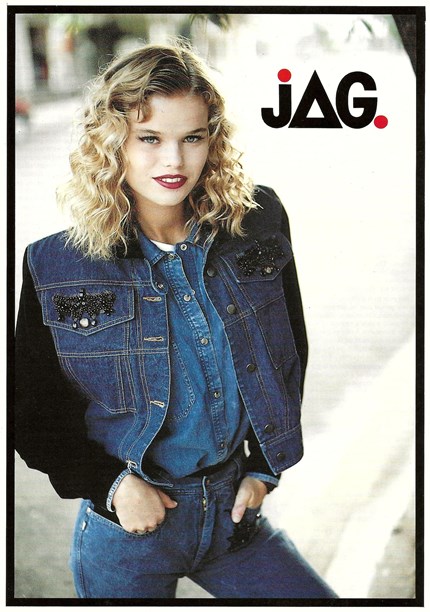
Jag indigo denim jeans, shirt and jacket with bead trim, shoulder pads and sleeves in a contrasting fabric, 1988.
Jean leg widths varied but generally speaking, Levi’s iconic 501s, reintroduced in the early 80s, set the standard for the classic straight-leg jean. Roomier cuts with more volume in the legs were also considered cool. The baggier styles often featured paper-bag waists, pulled in tightly with a belt or hanging from braces.
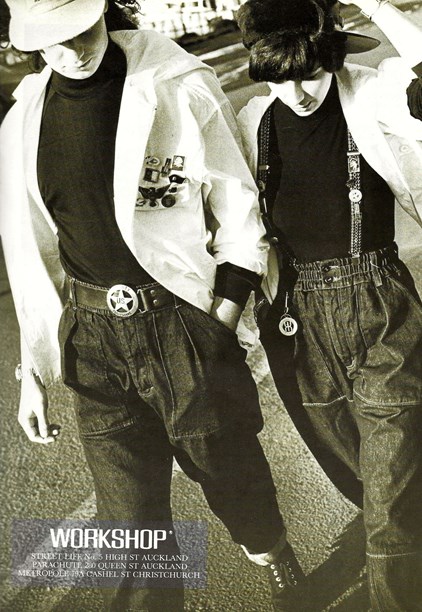
Workshop advertisement, ChaCha magazine, August 1987.
The denim market was a competitive one. When Desmond Williams photographed Rachel Hunter for Fashion Quarterly early in her modelling career, wearing a Dachet denim jacket and shorts and ‘pearls by Pascoes’, the image would have done much to raise the label’s profile. Still in her teens, Rachel appeared frequently in Fashion Quarterly's denim editorials and promotions.

Rachel Hunter models Dachet denims, multiple strings of pearls by Pascoes. Fashion Quarterly, early 1980s. Photo by Desmond Williams.
Other brands producing denim garments in New Zealand in the 1980s included Hot Cakes, Hero, Union Bay, Ton Sur Ton, Izona (incorporated into the Bendon Corporation in 1984), Wrangler, Euro Denim, Lee Cooper and Corfu Jeans. The latter, an Australian brand, was licensed to Braeden Manufacturing whose owner Ed Worthington made hats before moving into garment manufacturing, then specifically jeans. The brand’s success was partly attributable to its sizing policy – sizes 8, 9, 10, 11 and so on, not the two-size jumps most manufacturers favoured. Corfu’s other claim to fame was a line of maternity jeans which were fitted with a stretch Lycra tummy panel to allow for the expanding baby bump.

Advertisement for Corfu maternity jeans, 1984.
Adults were not the only ones to benefit from the denim fashion explosion. Scaled-down versions of jeans, dungarees, jackets and skirts were made for youngsters by Spaghetti, Levis and boutique childrenswear brands, among them Barbados, Tin Lid and Ruff ‘N Tumble. Age was no barrier when it came to denim. From washed-out fabric finishes to styling, junior jeanery was faithful in every detail to its grownup counterpart.
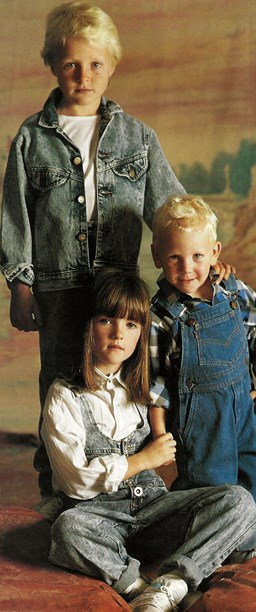
Denim designs for children by Levis, Barbados and Spaghetti. Fashion Quarterly, Winter 1988. Photo by Ken Middleton.
The 1980s are remembered for many fashion fads and foibles. They also live on in our collective memories as the decade that denim came of age.
Text by Cecilie Geary. Banner image of Vamp denim co-ordinates, 1988, © Vamp.
Published January 2020.